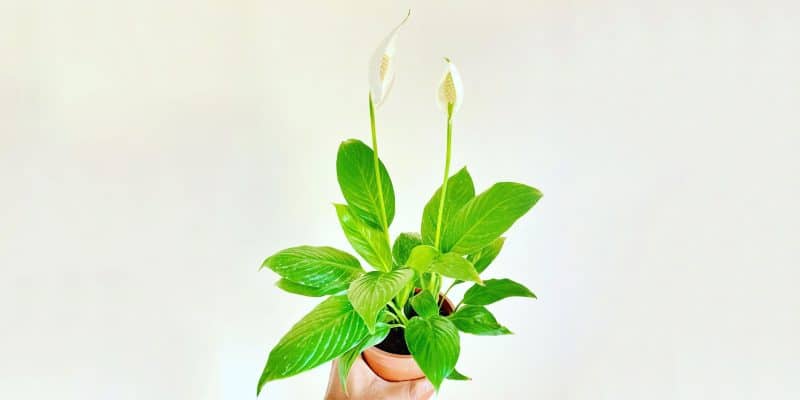Let us introduce you to the ever-popular Peace Lily, known for its graceful appearance and air-purifying abilities.
Now, don’t let its name fool you — though it’s called a Peace Lily, it’s not actually a lily at all! But it does have stunning white “flowers” and foliage that comes in a variety of shapes and sizes.
And, of course, we won’t leave you hanging on Peace Lily care indoors. Let’s get into all the tips and tricks you need to keep your plant healthy, happy, and blooming.
Table of Contents
Peace Lily Plant Care Guide
History, Habitat, and Characteristics
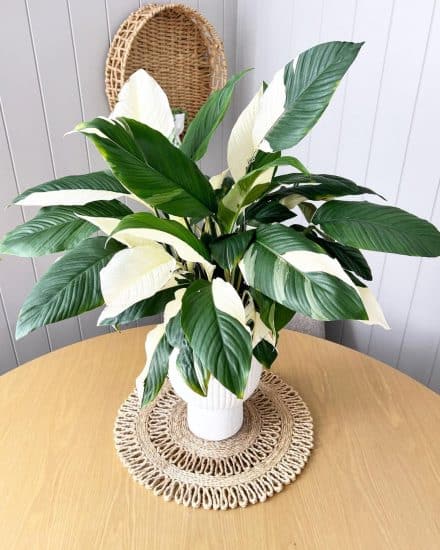
The Peace Lily (Spathiphyllum species) comes from the tropical regions of Central America and Asia. It’s been dazzling indoor spaces worldwide since it was first described back in 1824. With around 57 different species, there’s a whole world of leaf shapes and sizes to explore.
And despite its name, Peace Lilies aren’t true lilies at all! They actually belong to the Araceae family, making them close cousins of those trendy monsteras and philodendrons.
The name “peace lily” comes from its gorgeous white flowers, which look like they’re waving white flags of peace (aww, how sweet is that?). Fun fact: those white “flowers” are actually modified leaves called spathes.
Perhaps the coolest thing about the Peace Lily is its air-purifying superpowers. You’ve got a little hero right there in your living room, folks! It’s so good at neutralizing indoor pollutants like formaldehyde and carbon monoxide that NASA included it in its list of top air-purifying plants.
There are some popular Spathiphyllum varieties worth mentioning, each with its own charm:
- Domino Peace Lily, with snazzy variegated marbled leaves
- Silver Streak (or Platinum Mist) Peace Lily, with shimmering silver foliage
- Sweet Chico Peace Lily, for those who love a more slender and refined look
- White Stripe Peace Lily, compact, with a white stripe down each leaf
- Sensation Peace Lily, with leaves that can reach 6 feet
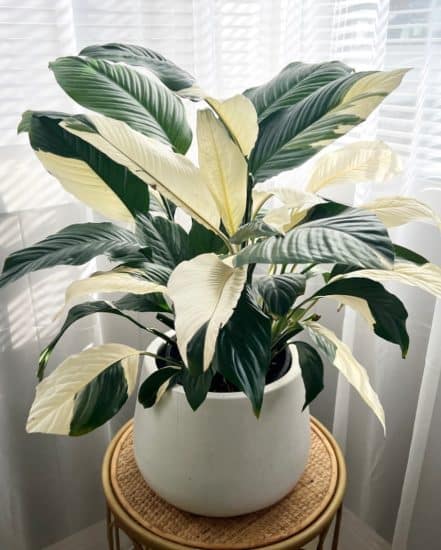
Last but not least, how do you get your Peace Lily plant to bloom? The trick is to treat it like it’s still in a tropical environment: Think consistent moisture, plenty of humidity, and bright, indirect sunlight. Give it the right TLC, and those showstopping white spathes will make an appearance!
Light
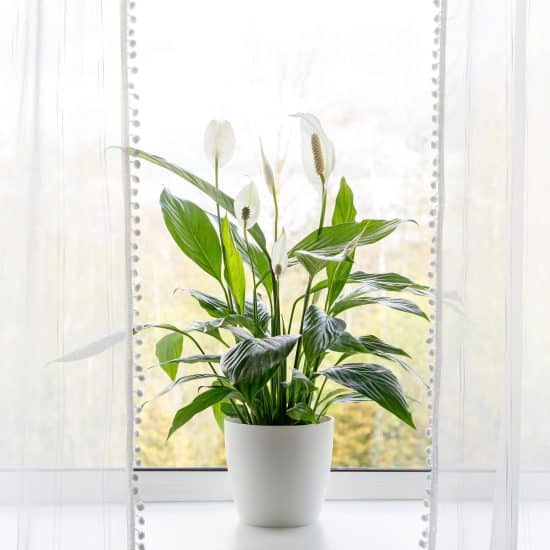
The best light for Peace Lily plants is bright, indirect light. Place your plant in a well-lit spot, ideally near an east- or north-facing window, but make sure it’s not too close. Peace Lily can handle a south- or west-facing window only if it’s more than a few feet away. Direct sun will burn your plant’s dark green leaves.
Most Peace Lilies grow well in lower light, but variegated types need a bit more light to keep their colors popping. And if you fancy Peace Lily flowers, bright indirect light is the way to go for these flowering plants. It’ll live in low light, but it’s less likely to bloom without indirect bright light.
If you notice yellowing leaves, your plant might be getting too much light. Brown and crispy leaves are a sure sign of too much direct sun, so you’ll want to move your Peace Lily farther from the window.
And while they are known as low-light plants, they need a fairly bright room to thrive. Too little light can cause yellow leaves as well. Make sure you aren’t taking Peace Lily’s low-light reputation too far.
Our lighting tips:
- Provide bright, indirect light, such as an east- or north-facing window.
- Avoid direct sunlight and keep the plant away from south- or west-facing windows.
- Use a sheer curtain to diffuse light from a too-bright window.
- Provide enough bright light for flowers to develop and bloom.
Water
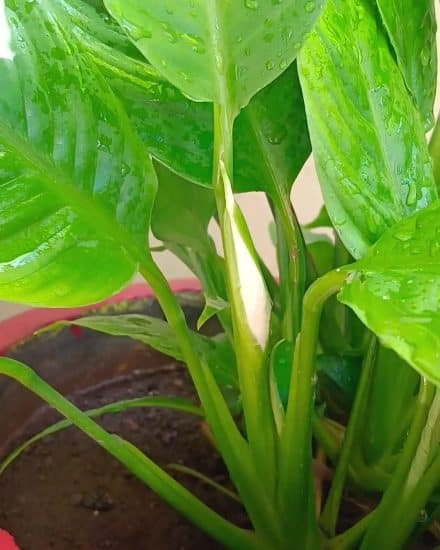
Peace Lilies like their soil to be slightly moist, but they also need time for the soil to dry out between waterings. Instead of watering on a schedule, which often leads to overwatering, feel the soil and water when the top 2 inches are dry.
When your Peace Lily isn’t getting enough water, its leaves will droop down, indicating that it’s time for a drink. To water your Peace Lilies properly, remember to use room temperature filtered water or unfiltered tap water that’s been left out overnight. This prevents harsh chemicals, like chlorine, from harming your sensitive plants.
Watch out for signs of excessive water, such as yellowing leaves, a mushy base, and soil that remains consistently damp. Overwatering is the most common way to kill a houseplant. If you see any of these symptoms, cut back on your watering frequency and let the soil dry out before the next watering session.
Our watering tips:
- Test the top inch or two of potting soil for dryness before watering.
- Use room temperature filtered water or tap water that’s been sitting out overnight to reduce chlorination.
- Thoroughly water your peace lilies, making sure excess water drains through the bottom of the pot.
Temperature and Humidity
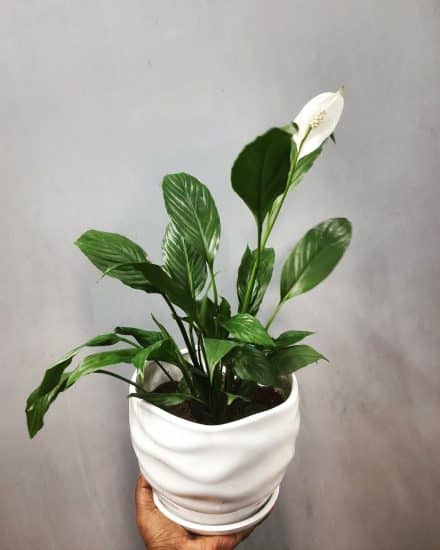
Peace Lily plants usually enjoy the same temperatures that we humans prefer, around 65 to 80°F (18-27°C). Just like us, they don’t appreciate drafts. Make sure not to place them near air vents, doors, or windows that you’ll use frequently. This helps avoid sudden temperature changes that might stress your plant.
If your Peace Lily’s leaves begin to wilt or droop, the temperature might be too low. On the other hand, if the leaves develop brown patches and appear to be scorched, your plant might be exposed to temperatures that are too high.
When it comes to humidity, Peace Lilies truly thrive in a moist environment. Aim for a consistent humidity of 50%-60%. A few handy ways to increase humidity around your plant include adding a small humidifier, placing it on a pebble tray, or grouping plants together.
If you notice the tips of the leaves becoming brown and crispy, the humidity is too low. Conversely, if the leaves appear yellow and soggy, they might be receiving too much humidity.
Soil and Planting
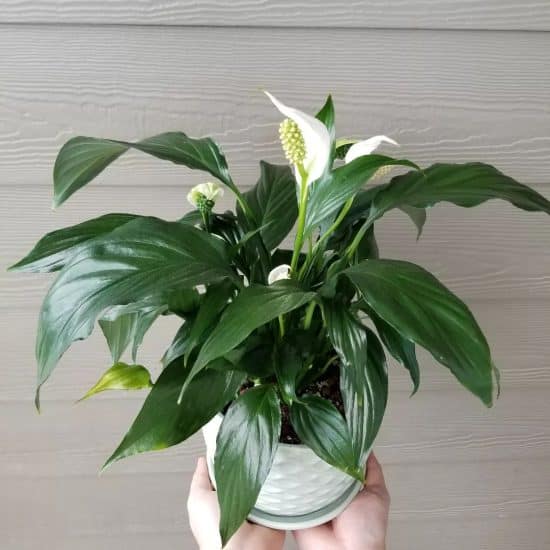
To create the ideal soil conditions for your potted Peace Lilies, mix together airy elements like bark and perlite with a base of coco coir (an eco-friendly alternative to peat moss). This combination allows for ample drainage while ensuring sufficient moisture retention.
Poor soil can lead to a variety of issues, such as root damage or poor nutrient uptake. Signs of poor soil quality also include yellowing leaves, wilting, and slow growth. If you notice these symptoms in your plant, consider changing the soil mixture to better suit its needs.
Sometimes these signs can indicate your plant is ready to be repotted. Peace Lilies grow well when they’re repotted every 1-2 years to refresh the soil and accommodate their growing root system. Repot in early spring, and gently remove the plant from its current container and place it in a new pot that’s slightly larger, with fresh soil and ample drainage.
Fertilizing
Feed Peace Lilies with a general-purpose fertilizer like Espoma, an organic option, once a month during the growing season. To avoid over-fertilizing, dilute the fertilizer to half the concentration recommended by the manufacturer. If you’ve just repotted, give your plant some time to acclimate to its new environment before adding nutrients.
Over-fertilizing Peace Lilies can cause problems. Excess salt buildup in the soil can burn or weaken the roots. It can also lead to a plant that grows too fast for its root system to keep up with. Symptoms of too much fertilizer include brown tips on leaves, yellowing of the leaves, and a lack of new growth.
If you suspect over-fertilization, flush the soil with water to remove excess salts and reduce the frequency or strength of future feedings.
Propagation Guide
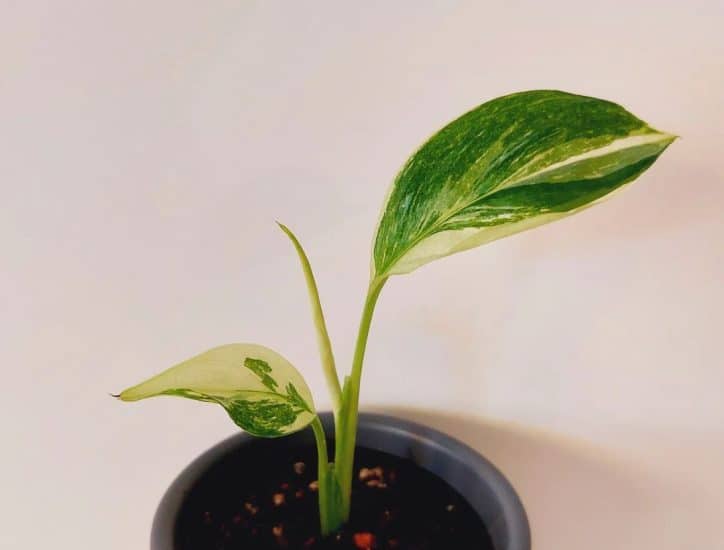
Propagating Peace Lilies through crown division is a piece of cake, and a fantastic way to gift your friends with a new plant — or keep it for yourself; no judgment here!
Propagate Peace Lily through crown division:
- Remove your plant from its pot and find the crown, where the roots meet the plant’s stem.
- Gently split the crown into two plants by carefully pulling it apart. Don’t freak out if you break some roots in the process — plants are resilient.
- Pop the separated crown into the same potting soil mix as the original plant to avoid sending it into shock. Make sure to tuck in the roots nicely with the soil by giving them a gentle press.
- Water your new plant moderately and place it in a spot with bright, indirect light. Keep an eye on it and give it the same care you’d give to a grown-up Peace Lily.
Common Issues
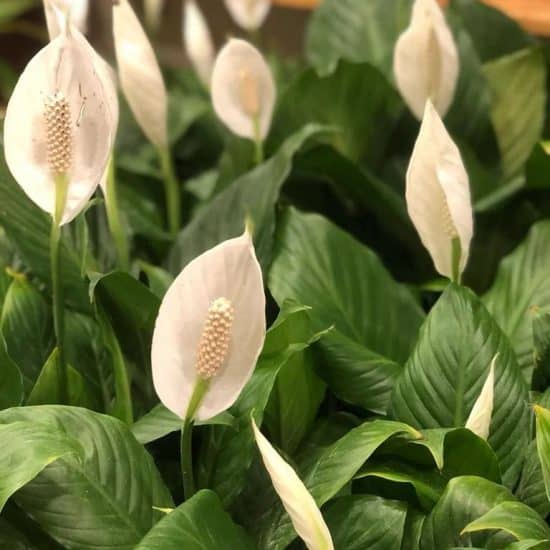
Drooping Leaves
Usually, drooping leaves mean your plant needs a drink. To fix drooping leaves, give your plant a good, thorough drink and make sure it’s draining well.
If you notice more drooping than usual, your plant could be root-bound and in need of repotting.
Yellowing Leaves
When Peace Lily leaves begin to turn yellow, it’s time to evaluate where your plant is hanging out. Check if it’s exposed to direct sunlight, a no-no for Peace Lilies — they prefer bright, indirect sunlight. Simply move your plant to a shadier spot or use a sheer curtain to soften the rays hitting your plant.
Other causes of yellow leaves:
- Too much fertilizer
- Too much water
- Water with chlorine or other impurities
- Exposure to extreme temperatures
- Pests and diseases
- Leaves that are simply old
Crispy and Brown Leaves
Your Peace Lily might be getting a bit too much direct sunlight. If the leaves are brown and dry, or even curling, it’s time to find a shadier location for your Peace Lily or use a sheer curtain to filter that intense sunlight.
Oh, and don’t forget to check your watering habits — make sure you’re giving your plant the right amount of water it needs to prevent those leaves from scorching. You may just need to increase the humidity. Try running a humidifier near your plant for a few hours each day.
Pests and Diseases
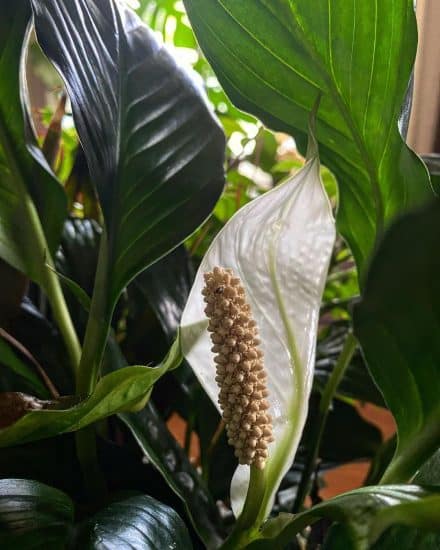
Spider Mites, Aphids, and Mealybugs
If your Peace Lily is struggling and you can’t figure out why, examine the leaves, especially the underside. Look for thin webbing, a cotton-like substance, or the unmistakable presence of little insect bodies crawling around your plant.
Found the culprits? Start by isolating your plant to keep those uninvited guests from infesting the rest of your collection. Next, gently wipe off the leaves with a damp cloth or cotton swab to remove the pests.
Then, treat your Peace Lily with some natural insecticidal soap, diluted neem oil, or an appropriate pesticide following the label instructions. Keep a close eye and repeat as needed because these bugs can be persistent.
Regularly inspect your Peace Lily and other houseplants to catch issues early. Keep your plant spaces well-ventilated, and avoid overwatering.
Root Rot
Root rot, the bane of many indoor plants (including our dear Peace Lily), often comes from overwatering or poor drainage. What happens is the roots drown in anaerobic conditions, harmful fungi or bacteria creep in, and things head south quickly.
To diagnose rotting roots, look for yellowing leaves, wilting, and a not-so-pleasant smell from the soil. Inspect the roots — if they appear black, slimy, and mushy, bingo, it’s rot. What to do? Gently remove your Peace Lily from its pot and use sterilized scissors or pruning shears and cut away the rotting roots.
Get a new pot, one with drainage holes, fill it with fresh, well-draining soil, and maybe throw in some perlite, pumice, or LECA for extra aeration and drainage. Repot your Peace Lily and allow the top few inches of soil to dry out before you water.
Conclusion
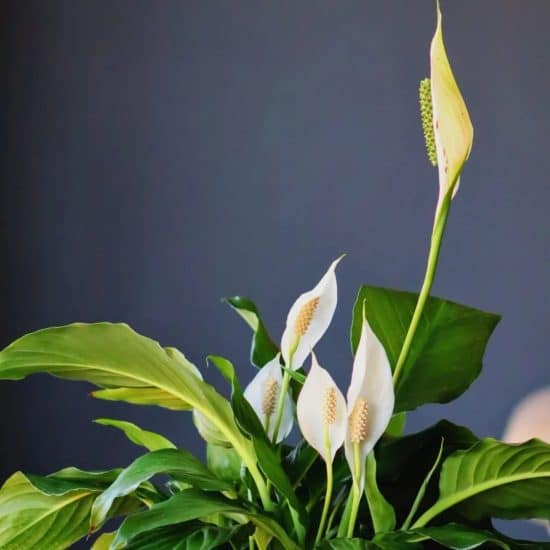
That’s a wrap for our Peace Lily care guide! You’re now equipped with all the knowledge you need to help your Spathiphyllum shine, from mastering its light requirements to conquering watering woes and everything in between.
Peace Lily care summary:
- Grow Peace Lilies in indirect bright light.
- Keep them out of direct sunlight.
- Keep the soil lightly moist, and water when the top 2 inches are dry.
- Fertilize lightly in the growing season.
- Repot every 1-2 years.
- Propagate by crown division.
Should you have any questions or concerns, don’t hesitate to reach out to us. And if you found our guide helpful, don’t forget to share it with fellow plant lovers!
Take care, and peaceful plant parenting!
FAQ
Should I cut the brown leaf tips off my Peace Lily?
Absolutely, snip them right off! Trimming the brown tips from your Peace Lily’s leaves not only keeps the plant looking tidy but also lets it focus its energy on healthier growth. Just remember to use clean, sharp scissors or pruning shears, and make a gentle, angled cut just before where the brown tip begins.
Can I keep Peace Lilies outside, and how does care differ?
Sure, Peace Lilies can enjoy outdoor living — carefully. First, be mindful of extremely hot or cold temperatures. These tropical beauties prefer temps between 65°F-80°F, and they’re not fans of sudden drops or spikes. So choose a sheltered spot where your Peace Lily is protected from drafts, strong winds, and severe temperature fluctuations.
Second, remember those bright, indirect light preferences we talked about earlier? That rule still applies outdoors! Make sure your Peace Lily is placed in shady, dappled sunlight to prevent sunburn and keep those leaves looking fresh.
Finally, you may need to adjust your watering routine a bit when growing Peace Lilies outside. Outdoor conditions can cause the soil to dry out more quickly, so check the soil’s moisture regularly and water as needed to maintain that nice, even moisture your plant loves.

